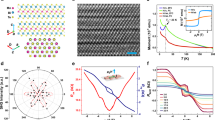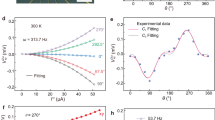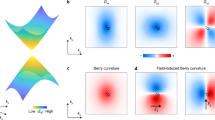Abstract
The rapid expansion of self-powered electronics in the Internet of Things, 6G communication and millimetre-wave systems calls for rectifiers capable of operating across ultrabroadband frequencies and at extremely low input power levels. However, conventional rectifiers based on semiconductor junctions face fundamental limitations such as parasitic capacitance and threshold voltages, preventing effective operation under broadband and ambient radio-frequency conditions. Here we present an ultrabroadband, zero-bias rectifier based on the nonlinear Hall effect in wafer-scale (001)-oriented topological crystalline insulator SnTe thin film. This material exhibits a large second-order conductivity of ~0.004 Ω⁻1 V⁻1, surpassing that of other wafer-scale materials. The nonlinear Hall effect arises primarily from a Berry curvature dipole, evidenced by angular-resolved transport measurements and first-principles calculations. The device demonstrates rectification from 23 MHz to 1 THz, with sensitivity down to –60 dBm in key radio-frequency bands, without any external bias. Rectified output power is scalable through series- and parallel-array topologies and can be enhanced using rectenna designs. As a proof of concept, we achieve the wireless powering of a thermistor using harvested radio-frequency energy, validating the potential of this material platform and nonlinear Hall effect for next-generation energy-autonomous microsystems.
This is a preview of subscription content, access via your institution
Access options
Access Nature and 54 other Nature Portfolio journals
Get Nature+, our best-value online-access subscription
$32.99 / 30 days
cancel any time
Subscribe to this journal
Receive 12 print issues and online access
$259.00 per year
only $21.58 per issue
Buy this article
- Purchase on SpringerLink
- Instant access to full article PDF
Prices may be subject to local taxes which are calculated during checkout




Similar content being viewed by others

Data availability
The data that support the findings of this study are available within the article and its Supplementary Information. Other relevant data are available from the corresponding authors upon reasonable request.
References
Wang, W. et al. On-chip topological beamformer for multi-link terahertz 6G to XG wireless. Nature 632, 522–527 (2024).
Saad, W., Bennis, M. & Chen, M. A vision of 6G wireless systems: applications, trends, technologies, and open research problems. IEEE Netw. 34, 134–142 (2020).
Rangan, S., Rappaport, T. S. & Erkip, E. Millimeter-wave cellular wireless networks: potentials and challenges. Proc. IEEE 102, 366–385 (2014).
Portilla, L. et al. Wirelessly powered large-area electronics for the Internet of Things. Nat. Electron. 6, 10–17 (2023).
Sharma, R. et al. Nanoscale spin rectifiers for harvesting ambient radiofrequency energy. Nat. Electron. 7, 653–661 (2024).
Hemour, S. et al. Towards low-power high-efficiency RF and microwave energy harvesting. IEEE Trans. Microw. Theory Techn. 62, 965–976 (2014).
Sharma, R. et al. Electrically connected spin-torque oscillators array for 2.4 GHz WiFi band transmission and energy harvesting. Nat. Commun. 12, 2924 (2021).
Zhang, X. et al. Two-dimensional MoS2-enabled flexible rectenna for Wi-Fi-band wireless energy harvesting. Nature 566, 368–372 (2019).
Roy, S., Tiang, R. J.-J., Roslee, M. B., Ahmed, Md. T. & Mahmud, M. A. P. Quad-band multiport rectenna for RF energy harvesting in ambient environment. IEEE Access 9, 77464–77481 (2021).
Le, M. T., Ngo, V. D., Nguyen, T. T. & Nguyen, Q. C. Dual-band ambient energy harvesting systems based on metamaterials for self-powered indoorwireless sensor nodes. Int. J. Microw. Wirel. Technol. 14, 1270–1278 (2022).
Sodemann, I. & Fu, L. Quantum nonlinear Hall effect induced by Berry curvature dipole in time-reversal invariant materials. Phys. Rev. Lett. 115, 216806 (2015).
Onishi, Y. & Fu, L. High-efficiency energy harvesting based on a nonlinear Hall rectifier. Phys. Rev. B 110, 075122 (2024).
Isobe, H., Xu, S.-Y. & Fu, L. High-frequency rectification via chiral Bloch electrons. Sci. Adv. 6, eaay2497 (2020).
Zhang, Y. & Fu, L. Terahertz detection based on nonlinear Hall effect without magnetic field. Proc. Natl Acad. Sci. USA 118, e2100736118 (2021).
Ma, Q. et al. Observation of the nonlinear Hall effect under time-reversal-symmetric conditions. Nature 565, 337–342 (2019).
Valenta, C. R. Fundamental limitations for Schottky diode RF energy harvesting. In IEEE International Conference on RFID Technology and Applications (RFID-TA) 188–193 (IEEE, 2015).
He, P. et al. Graphene moiré superlattices with giant quantum nonlinearity of chiral Bloch electrons. Nat. Nanotechnol. 17, 378–383 (2022).
Kang, K., Li, T., Sohn, E., Shan, J. & Mak, K. F. Nonlinear anomalous Hall effect in few-layer WTe2. Nat. Mater. 18, 324–328 (2019).
Wang, N. et al. Quantum-metric-induced nonlinear transport in a topological antiferromagnet. Nature 621, 487–492 (2023).
Gao, A. et al. Quantum metric nonlinear Hall effect in a topological antiferromagnetic heterostructure. Science 381, 181–186 (2023).
Lu, X. F. et al. Nonlinear transport and radio frequency rectification in BiTeBr at room temperature. Nat. Commun. 15, 245 (2024).
Qin, M.-S. et al. Strain tunable Berry curvature dipole, orbital magnetization and nonlinear Hall effect in WSe2 monolayer. Chin. Phys. Lett. 38, 017301 (2021).
Huang, M. et al. Giant nonlinear Hall effect in twisted bilayer WSe2. Natl Sci. Rev. 10, nwac232 (2023).
Makushko, P. et al. A tunable room-temperature nonlinear Hall effect in elemental bismuth thin films. Nat. Electron. 7, 207–215 (2024).
Kumar, D. et al. Room-temperature nonlinear Hall effect and wireless radiofrequency rectification in Weyl semimetal TaIrTe4. Nat. Nanotechnol. 16, 421–425 (2021).
Min, L. et al. Strong room-temperature bulk nonlinear Hall effect in a spin-valley locked Dirac material. Nat. Commun. 14, 364 (2023).
Cheng, B. et al. Giant nonlinear Hall and wireless rectification effects at room temperature in the elemental semiconductor tellurium. Nat. Commun. 15, 5513 (2024).
Fu, L. Topological crystalline insulators. Phys. Rev. Lett. 106, 106802 (2011).
Hsieh, T. H. et al. Topological crystalline insulators in the SnTe material class. Nat. Commun. 3, 982 (2012).
Tanaka, Y. et al. Experimental realization of a topological crystalline insulator in SnTe. Nat. Phys. 8, 800–803 (2012).
Wang, F. et al. Chromium-induced ferromagnetism with perpendicular anisotropy in topological crystalline insulator SnTe (111) thin films. Phys. Rev. B 97, 115414 (2018).
Zeljkovic, I. et al. Dirac mass generation from crystal symmetry breaking on the surfaces of topological crystalline insulators. Nat. Mater. 14, 318–324 (2015).
Okada, Y. et al. Observation of Dirac node formation and mass acquisition in a topological crystalline insulator. Science 341, 1496–1499 (2013).
Knox, K. R., Bozin, E. S., Malliakas, C. D., Kanatzidis, M. G. & Billinge, S. J. L. Local off-centering symmetry breaking in the high-temperature regime of SnTe. Phys. Rev. B 89, 014102 (2014).
Chang, K. et al. Discovery of robust in-plane ferroelectricity in atomic-thick SnTe. Science 353, 274–278 (2016).
Su, Y. et al. Orientation-controlled synthesis and Raman study of 2D SnTe. Nanotechnology 34, 505206 (2023).
Zhang, C.-L. et al. Highly tunable topological system based on PbTe-SnTe binary alloy. Phys. Rev. Mater. 4, 091201 (2020).
He, P. et al. Quantum frequency doubling in the topological insulator Bi2Se3. Nat. Commun. 12, 698 (2021).
Park, Y. & Kim, H. On the coexistence of IEEE 802.11ac and WAVE in the 5.9 GHz Band. IEEE Commun. Mag. 52, 162–168 (2014).
Suárez-Rodríguez, M. et al. Microscale chiral rectennas for energy harvesting. Adv. Mater. 36, 2400729 (2024).
Hu, Z. et al. Terahertz nonlinear Hall rectifiers based on spin-polarized topological electronic states in 1T-CoTe2. Adv. Mater. 35, 2209557 (2023).
Zhang, L. et al. High-frequency rectifiers based on type-II Dirac fermions. Nat. Commun. 12, 1584 (2021).
Sanjuan, F., Gaborit, G. & Coutaz, J.-L. Sub-wavelength terahertz imaging through optical rectification. Sci. Rep. 8, 13492 (2018).
Carletti, L. et al. Nonlinear THz generation through optical rectification enhanced by phonon-polaritons in lithium niobate thin films. ACS Photonics 10, 3419–3425 (2023).
Liu, B. et al. W-band photonic pulse compression radar with dual transmission mode beamforming. J. Light. Technol. 39, 1619–1628 (2021).
Hemmetter, A. et al. Terahertz rectennas on flexible substrates based on one-dimensional metal-insulator-graphene diodes. ACS Appl. Electron. Mater. 3, 3747–3753 (2021).
Yao, L., Steyaert, M. S. J. & Sansen, W. A 1-V 140-µW 88-dB audio sigma-delta modulator in 90-nm CMOS. IEEE J. Solid-State Circuits 39, 1809–1818 (2004).
Leroux, P., Janssens, J. & Steyaert, M. A 0.8-dB NF ESD-protected 9-mW CMOS LNA operating at 1.23 GHz. IEEE J. Solid-State Circuits 37, 760–765 (2002).
Gentile, P. et al. Electronic materials with nanoscale curved geometries. Nat. Electron. 5, 551–563 (2022).
Schade, N. B., Schuster, D. I. & Nagel, S. R. A nonlinear, geometric Hall effect without magnetic field. Proc. Natl Acad. Sci. USA 116, 24475–24479 (2019).
Acknowledgements
This research was supported by the National Research Foundation (NRF) Singapore Investigatorship (NRFI06-2020-0015) (H.Y.), A*STAR under its Quantum Engineering Programme (NRF2022-QEP2-03-P13) (H.Y.), National Key Research and Development Program of China (2022YFB3505301) (X.X.), National Natural Science Foundation of China (52471253 and 12174237) (F.W. and X.X.), Central Government’s Special Fund for Local Science and Technology Development (YDZJSX2024D058) (F.W.) and Fund Program for the Scientific Activities of Selected Returned Overseas Professionals in Shanxi Province (20240019) (F.W.). R.S. acknowledges the Anusandhan National Research Foundation (ANRF) for the Prime Minister’s Early Career Research Grant (ANRF/ECRG/2024/006343/ENS).
Author information
Authors and Affiliations
Contributions
H.Y. and F.W. conceived of and designed the experiments. F.H. fabricated the rectification devices and carried out the rectification measurements. S.Z. prepared the setups for rectification measurements. J. Lei and F.H. performed the equation derivation for rectified power and thermistor measurements. F.H. and S.Z. analysed the rectification data. P.Z. and Z.Y. grew the samples and carried out the X-ray diffraction measurements. L.Y. and J. Lai fabricated the transport devices and performed the transport measurements. F.W. and F.H. analysed the transport data. W.L. performed the theoretical calculations under the supervision of S.A.Y. H.P. conducted the second-harmonic measurements. C.W. performed the Raman measurements under the supervision of G.E. R.S. helped in the interpretation and figure preparation of the rectification data. F.H., F.W., R.S. and H.Y. wrote the paper with contributions from all authors. H.Y. supervised the project. All authors discussed the results and commented on the paper.
Corresponding authors
Ethics declarations
Competing interests
The authors declare no competing interests.
Peer review
Peer review information
Nature Nanotechnology thanks Faxian Xiu, Peide Ye and the other, anonymous, reviewer for their contribution to the peer review of this work.
Additional information
Publisher’s note Springer Nature remains neutral with regard to jurisdictional claims in published maps and institutional affiliations.
Supplementary information
Supplementary Information
Supplementary Figs. 1–46, Table 1, Notes 1–24 and References.
Rights and permissions
Springer Nature or its licensor (e.g. a society or other partner) holds exclusive rights to this article under a publishing agreement with the author(s) or other rightsholder(s); author self-archiving of the accepted manuscript version of this article is solely governed by the terms of such publishing agreement and applicable law.
About this article
Cite this article
Hu, F., Zhao, P., Yang, L. et al. Ultrabroadband nonlinear Hall rectifier using SnTe. Nat. Nanotechnol. (2025). https://doi.org/10.1038/s41565-025-01993-2
Received:
Accepted:
Published:
DOI: https://doi.org/10.1038/s41565-025-01993-2


